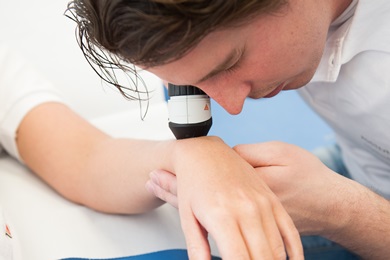Different skin cancer signs
There are many different types of skin cancer, the most frequent ones being basal cell carcinoma, squamous cell carcinoma and melanoma. The skin cancer signs differ for each type. A basal cell carcinoma can be recognized by a pearly translucent to flesh like color, small blood vessels on its surface area and sometimes ulceration of the skin. Squamous cell carcinoma commonly looks like a red scaly patch or bump that is crusted. It is often fast growing. A melanoma often is an asymmetrical pigmented area, bigger than 5 millimeters in diameter, with a color that varies from the surrounding skin and an irregular border. All these types of cancer are almost always caused by UV-light (from the sun). Risk factors for these types of skin cancer are therefore: sun vacations, being an outside professional, outside sports or recreation, sun tanning beds and living near the equator. Melanoma can also be inherited, which is why dermatologists always ask if this is something common in your family.
Skin cancer treatment
The treatment depends on the type of cancer you can follow this link for more information in Dutch. In some cases a topical cream can be used to treat basal cell carcinomas. However, most of the times the cancer must be excised. After an excision the pathologist can check if the lesion is removed entirely, which is a great advantage. Dermatologists at the Roosevelt clinic are very experienced, well trained dermato-surgeons. Melanomas are removed and then another excision around the scar is performed as prescribed in the Dutch guidelines of Melanoma treatment. In some exceptional cases patients need to get a referral to an academic center.
Treatment costs
If referred to the Roosevelt clinic by your general practitioner, the treatment costs are paid for by your health care insurance. It is also possible to make an appointment without a referral. Then you have to pay for a full body check for skin cancer. You can find the costs here. The dermatologist will inform you on any irregularities he or she suspects to be a carcinoma. Lesions can be removed surgically and analyzed by a pathologist. This procedure will carry extra costs. For a pricelist click here or ask your dermatologist what the costs will be. It is advisable to get a referral from your general practitioner in most cases.
Make an appointment with the dermatologist, click here.
